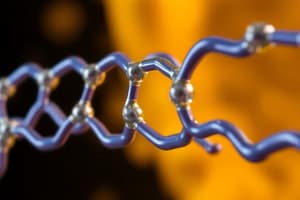Podcast
Questions and Answers
Which component of the plasma membrane is primarily responsible for its selective permeability?
Which component of the plasma membrane is primarily responsible for its selective permeability?
- Cholesterol molecules interspersed within the bilayer.
- The arrangement of proteins and lipids creates a barrier that only allows certain substances through. (correct)
- The glycerol backbone provides a rigid structure that blocks large molecules.
- The hydrophilic heads of the phospholipid molecules.
How do the hydrophobic and hydrophilic properties of phospholipids contribute to forming a stable cell membrane in an aqueous environment?
How do the hydrophobic and hydrophilic properties of phospholipids contribute to forming a stable cell membrane in an aqueous environment?
- Both hydrophobic and hydrophilic parts are evenly distributed, creating a uniform interaction with water.
- Hydrophobic heads form a single layer that repels water, while hydrophilic tails are dispersed throughout the solution.
- Hydrophilic heads face both the interior and exterior aqueous environments, while hydrophobic tails face inward, away from water. (correct)
- Hydrophilic tails face outward, interacting with water, while hydrophobic heads face inward, avoiding water.
In passive transport, what primarily drives the movement of substances across the cell membrane?
In passive transport, what primarily drives the movement of substances across the cell membrane?
- The physical size of the molecule being transported.
- The electrochemical gradient of the substance being transported. (correct)
- The interaction of the substance with the hydrophobic core of the membrane.
- The hydrolysis of ATP by transport proteins.
What is the role of transport proteins in facilitated diffusion?
What is the role of transport proteins in facilitated diffusion?
How does the 'self-sealing' property of the phospholipid bilayer contribute to the function of the plasma membrane?
How does the 'self-sealing' property of the phospholipid bilayer contribute to the function of the plasma membrane?
What is the primary difference between carrier proteins and channel proteins in membrane transport?
What is the primary difference between carrier proteins and channel proteins in membrane transport?
Which of the following transport mechanisms is considered active transport?
Which of the following transport mechanisms is considered active transport?
How does the plasma membrane facilitate cell communication and recognition?
How does the plasma membrane facilitate cell communication and recognition?
Flashcards
Fluid Mosaic Model
Fluid Mosaic Model
A model describing the plasma membrane as a flexible lipid bilayer with proteins embedded throughout.
Amphipathic
Amphipathic
Having both water-attracting (hydrophilic) and water-repelling (hydrophobic) parts.
Hydrophobic Tail
Hydrophobic Tail
The tail region of a phospholipid is repelled by water
Hydrophilic Head
Hydrophilic Head
Signup and view all the flashcards
Selectively Permeable Membrane
Selectively Permeable Membrane
Signup and view all the flashcards
Concentration Gradient
Concentration Gradient
Signup and view all the flashcards
Passive Transport
Passive Transport
Signup and view all the flashcards
Active Transport
Active Transport
Signup and view all the flashcards
Study Notes
- Cell Membranes relate to Structure, Transport, and Linking Cells
- The information corresponds to Topic Outline L15 and L16
Plasma Membrane Structure
- The Fluid Mosaic Plasma Membrane Model consists of a phospholipid bilayer with attached and embedded proteins and cholesterol
- Phospholipids have a structure and organization with the membrane
- Proteins have four describable functions
- Selectively permeable or semipermeable means it allows only certain substances to pass through
Membrane Phospholipids
- Membrane Phospholipids have a structure that should be recognized and able to be drawn
- It has two main parts, the head and tail
- A bridging part is one glycerol backbone
- Hydrophobic is a defined trait
- Hydrophilic is a defined trait
Bilayer Structure and Formation of the Cell Membrane
- Conflicting forces arise when phospholipids are placed in water
- These conflicting forces create the phospholipid bilayer
- Phospholipid orientation occurs in each of the layers within the phospholipid bilayer
- The phospholipid bilayer membrane is self-sealing
- Phospholipid bilayer membrane forms an internal barrier inside the body
Five Functions of the Plasma Membranes
- There are five describable functions of the plasma membranes
Membrane Transport
- Membrane Transport is selectively permeable
- Transport mechanisms relate to small non-polar molecules, uncharged polar molecules, and ions and charged molecules
- Transporter Proteins involve carriers and channels
- Concentration gradients must be explained
Passive Transport
- Passive Transport has a describable direction of movement across a membrane
- Simple diffusion involves a general mechanism
- Facilitated diffusion involves a general mechanism
- A transporter protein conformational change is required for facilitated diffusion
Active Diffusion
- Active Diffusion has a describable direction of movement across the membrane
- Active Diffusion involves a general mechanism of "pumps"
- Transporter protein conformational change is required for active diffusion
Bulk Transport
- Endocytosis has a general mechanism
- Endocytosis can be either passive or active transport
- Endocytosis has a direction of movement across the membrane
- Endocytosis includes phagocytosis, pinocytosis, and receptor-mediated
- Exocytosis has a general mechanism
- Exocytosis can be either passive or active transport
- Exocytosis has a direction of movement across the membrane
Linking Cells to Other Cells
- Tight Junctions have a location in cells
- Tight Junctions have functions and structure
- Tight Junctions have examples
- Desmosomes (also known as Anchoring, Junctions, Adhesion Junctions) have a location in cells
- Desmosomes (also known as Anchoring, Junctions, Adhesion Junctions) have functions and structure
- Desmosomes (also known as Anchoring, Junctions, Adhesion Junctions) have examples
- Gap Junctions have a location in cells
- Gap Junctions have functions and structure
- Gap Junctions have examples
Cancer Cells Lose Their Connections
- Metastasis involves a general mechanism
Studying That Suits You
Use AI to generate personalized quizzes and flashcards to suit your learning preferences.




